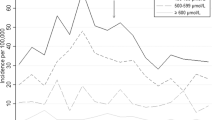Abstract
Currently, active public health surveillance of hyperbilirubinemia and kernicterus is lacking. Recently, the Hospital Corporation of America (HCA), a private health care system with an estimated quarter of a million births annually, instituted recommendations to provide universal hyperbilirubinemia screening before discharge for all infants born within their system. Over 98% of the infants born at HCA hospitals were screened within the first year of the recommendations. From May to December 2004, 13 infants were identified with total serum bilirubin (TSB) ⩾30 mg per 100 ml, but that number was reduced in 2006, with only seven infants born in HCA hospitals developing a TSB of ⩾30 mg per 100 ml. This program provides a model for actively monitoring the occurrence of hyperbilirubinemia and for tracking its occurrence, thus improving health care quality for patients while collecting important public health information.
This is a preview of subscription content, access via your institution
Access options
Subscribe to this journal
Receive 12 print issues and online access
$259.00 per year
only $21.58 per issue
Buy this article
- Purchase on Springer Link
- Instant access to full article PDF
Prices may be subject to local taxes which are calculated during checkout
Similar content being viewed by others
References
American Academy of Pediatrics. Practice parameter: management of hyperbilirubinemia in the healthy term newborn. American Academy of Pediatrics. Provisional Committee for Quality Improvement and Subcommittee on Hyperbilirubinemia. Pediatrics 1994; 94 (4 Part 1): 558–565.
Vreman HJ, Wong RJ, Stevenson DK . Phototherapy: current methods and future directions. Semin Perinatol 2004; 9 (3): 326–333.
American Academy of Pediatrics. Management of hyperbilirubinemia in the newborn infant 35 or more weeks of gestation. Pediatrics 2004; 114 (1): 297–316.
Bhutani VK, Johnson LH, Shapiro SM . Kernicterus in sick and preterm infants (1999–2002): a need for an effective preventive approach. Semin Perinatol 2004; 28 (5): 319–325.
Centers for Disease Control Prevention. Kernicterus in full-term infants–United States, 1994–1998. Morb Mortal Wkly Rep 2001; 50 (23): 491–494.
Johnson LH, Bhutani VK, Brown AK . System-based approach to management of neonatal jaundice and prevention of kernicterus. J Pediatr 2002; 140 (4): 396–403.
Bhutani VK, Donn SM, Johnson LH . Risk management of severe neonatal hyperbilirubinemia to prevent kernicterus. Clin Perinatol 2005; 32 (1): 125–139, vii.
Weber D . HealthStyles 2005 Survey. Porter Novelli: GA, USA, 2005.
Newman TB, Maisels MJ . Evaluation and treatment of jaundice in the term newborn: a kinder, gentler approach. Pediatrics 1992; 89 (5 Part 1): 809–818.
Bhutani VK, Johnson L, Sivieri EM . Predictive ability of a predischarge hour-specific serum bilirubin for subsequent significant hyperbilirubinemia in healthy term and near-term newborns. Pediatrics 1999; 103 (1): 6–14.
Centers for Disease Control and Prevention. Trends in length of stay for hospital deliveries—United States, 1970–1992. MMWR Morb Mortal Wkly Rep 1995; 44 (17): 335–337.
Fox MH, Kanarek N . The effects of newborn early discharge on hospital readmissions. Am J Med Qual 1995; 10 (4): 206–212.
Tai-Seale M, Rodwin M, Wedig G . Drive-through delivery: where are the ‘savings’? Med Care Res Rev 1999; 56 (1): 30–46.
JCAHO Sentinel Event Alert. Kernicterus threatens healthy babies. Issue 18, 1 April 2001; available at http://www.jointcommission.org/SentinelEvents/SentinelEventAlert.
Hospital Corporation of America. A multi-hospital system′s approach to a newborn bilirubin of 30 or greater as a ‘Never Event’. Two years of data collection. Poster presented at the National Patient Safety Foundation, Washington, DC, May 2007.
Acknowledgements
We thank Janet Meyers, Donna Frye and the HCA Perinatal Safety Initiative Clinical Work Groups for their contribution and efforts to prevent kernicterus.
Author information
Authors and Affiliations
Corresponding author
Additional information
Disclosure
The findings and conclusions in this report are those of the authors and do not necessarily represent the official position of the Centers for Disease Control and Prevention. The authors have declared no financial interests.
Rights and permissions
About this article
Cite this article
Lazarus, C., Avchen, R. Neonatal hyperbilirubinemia management: a model for change. J Perinatol 29 (Suppl 1), S58–S60 (2009). https://doi.org/10.1038/jp.2008.217
Published:
Issue Date:
DOI: https://doi.org/10.1038/jp.2008.217
Keywords
This article is cited by
-
Infants at risk of significant hyperbilirubinemia in poorly-resourced countries: evidence from a scoping review
World Journal of Pediatrics (2015)
-
Clinical report from the pilot USA Kernicterus Registry (1992 to 2004)
Journal of Perinatology (2009)
-
A proposal to prevent severe neonatal hyperbilirubinemia and kernicterus
Journal of Perinatology (2009)



